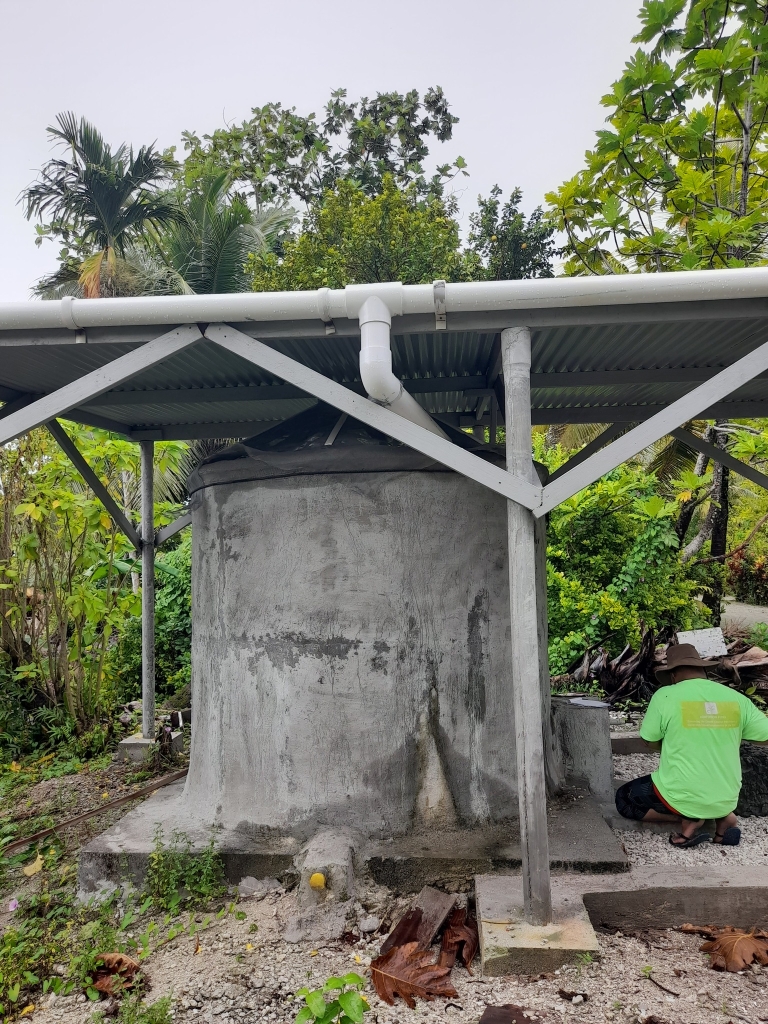
6 September 2024, Pohnpei FSM - Nukuoro and Kapingamarangi Islands are two of five outer islands of Pohnpei, occupied by vibrant communities with deep cultural roots.
The pristine and turquoise lagoons surrounding the islands make them some of the most beautiful islands amongst the Federated States of Micronesia’s (FSM) more than 600 islands dotted across the Western Pacific Ocean.
But the natural beauty of the islands hide a historical and growing pain. The communities living on these islands battle unprecedented challenges brought about by climate change where one of the most pressing issues is water scarcity as a result of frequent droughts and changing weather patterns.
A teacher and 36-year-old mother of three, Ms Marmina Jacobs, of Nukuoro, tells a tale of struggles and hardship in accessing safe and clean drinking water.
“We need water, without water we cannot survive. I am a mother and a teacher and in both those roles for me, water is a constant struggle,” she said.
With limited fresh water resources on the islands, Ms Jacobs and people of Nukuoro and Kapingamarangi rely heavily on rain water collection. “Our main source of water is the rain but sometimes we run out and when there is a drought, we have to try and manage with little or no water at all,” added Ms Jacobs.
The good news is that things are slowly changing for the better thanks to the “Enhancing the Climate Change Resilience of Vulnerable Island Communities in the Federated States of Micronesia” project. Funded by the Adaptation Fund (AF), and implemented by the Secretariat of the Pacific Regional Environment Programme (SPREP) through the FSM Department of Environment, Climate Change and Emergency Management (DECEM) and the states environmental protection and utility agencies, various utilities partners, the project aims to build the resilience of the communities and reduce their vulnerabilities to climate change impacts.
A significant part of the project is repairing and installing new rainwater tanks to ensure community members have easy accessibility to the water. For example, on the island of Nukuoro because of limited space, the rainwater tanks were placed behind a church building making it difficult for community to access. One of the solutions was to install small pressure water pumps near the tanks so it can pump water to the collection area near the road for easy access.
Project Manager, Mr Richard Moufa, said the project ensures all community members benefit from the project activity.
“The project highlights the needs of elderlies and people with special needs by prioritising their water infrastructures to be repaired and installed new tanks if necessary,” he said.
Ms Permina Esina, of Nukuoro, welcomes the project.
“Our community has embraced this project because we have seen how it is making a difference in terms of collecting water we need for survival,” she said.
Mr Juity Hainrich, Mayor Rep of Nukuoro, agrees and added: “Water is probably the most important need on the island, it is why this project focussing on repairing water catchment areas is vital and we look forward to continuing to work with our officials to see this through.”
Similar sentiments are echoed by the people of Kapingamarangi Island. “The water tanks project has been a huge help to our people,” said Mr Shelton Lomboi. “Before it started, a lot of the water tanks were broken and not working but they have brought cement and used it to patch up all the holes and now they are working fine.”
But there are other challenges.

The Executive Officer of Pohnpei State Environment Protection Agency (EPA), Mr Francisco Celestin, said accessing the islands is difficult due to the availability of vessels. Sometimes there is a delay of up to four months as a result.
“That is one of the main challenges we face with the implementation of the project on those two islands, it’s travelling there and back and transporting equipment, construction materials and rain water harvesting materials required for the work to be done,” he said. “Sometimes the project resorts to chartering vessels to transport materials to the islands.”
Still the “Enhancing the Climate Change Resilience of Vulnerable Island Communities in the Federated States of Micronesia” project team is determined.
“There has been a lot of improvement on the islands especially around the water catchment areas in general,” said Mr Leereson Airens, Chief of Water.
“A lot of the work focussed on repairs and maintenance of these catchment areas which has led to some improvements but we still have more work to do and we want to ensure this work continues for the betterment of our communities.”
The FSM AF project is valued at US $9,000,000 and ends in September 2025.
To find out more, visit: https://www.adaptation-fund.org/project/enhancing-climate-change-resilience-vulnerable-island-communities-federated-states-micronesia/